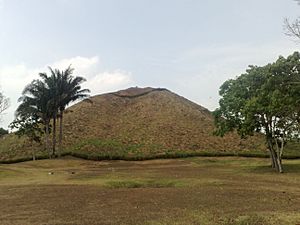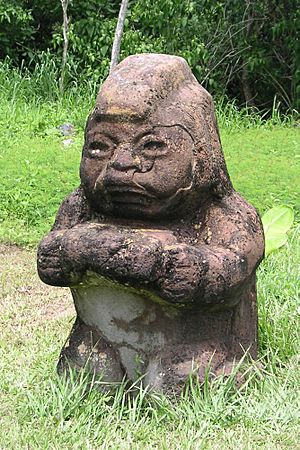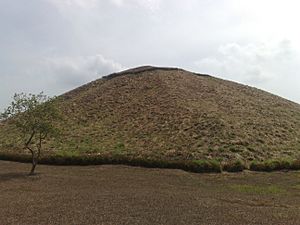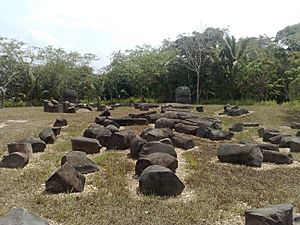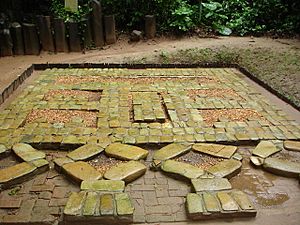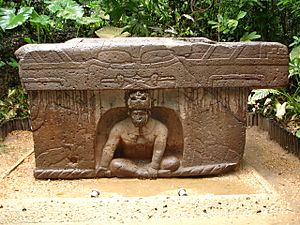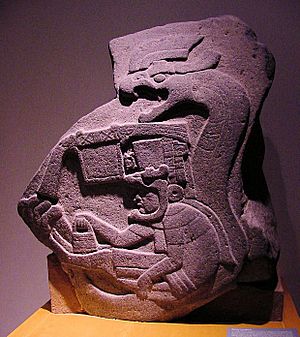La Venta facts for kids
La Venta is an important archaeological site from the Olmec civilization. It is located in the Mexican state of Tabasco. The Olmec people lived here long before Christopher Columbus arrived in the Americas. Many of the amazing artifacts found at La Venta have been moved to a museum called "Parque - Museo de La Venta" in the nearby city of Villahermosa.
Contents
Discovering the Olmec City
The Olmec were one of the very first major civilizations to grow in the Americas. They lived in what is now Mexico. Historians divide their time into three main periods: Early Formative (1800-900 BCE), Middle Formative (900-400 BCE), and Late Formative (400 BCE-200 AD). The Olmec are often called the "mother culture" of Mesoamerica. This means their ideas and way of life spread and influenced many later cultures, like the Maya and Aztecs.
The Olmec civilization started around 1600 BCE in the lowlands along the Gulf of Mexico. This area is known as the Olmec heartland, covering parts of Veracruz and Tabasco. Before La Venta became famous, another Olmec city called San Lorenzo was the main center from 1200-900 BCE.
The Olmec heartland is about 200 kilometers (124 miles) long and 80 kilometers (50 miles) wide. Important Olmec sites like La Venta, San Lorenzo Tenochtitlán, Laguna de los Cerros, and Tres Zapotes are all found here.
La Venta became the most important Olmec center after San Lorenzo declined, around 900 BCE. After being a major city for about 500 years, La Venta was mostly abandoned by the early 4th century BCE.
Where is La Venta Located?
La Venta is built on an island in a coastal swamp. It was once near a river called the Río Palma or Río Barí. The city likely controlled the area between the Mezcalapa and Coatzacoalcos rivers. The site itself is about 16 kilometers (10 miles) inland and sits less than 10 meters (33 feet) above sea level. The island is just over 2 square miles (5 square kilometers) of dry land.
The climate in La Venta is hot and humid. The average temperature is 26 degrees Celsius (79 degrees Fahrenheit), and it gets a lot of rain, about 2,000 millimeters (79 inches) each year. La Venta is special because it's located where four different natural areas meet: marshes, mangrove swamps, tropical forests, and the Gulf of Mexico.
City Layout and Buildings
La Venta was a large city with many people living there. It had special workers who didn't just grow food, and it had connections with other nearby towns. Sadly, most of the regular houses around the city's main areas have not survived over time.
The main part of La Venta is made up of clay buildings that stretch for 20 kilometers (12 miles) from north to south. The city is actually angled about 8 degrees west of true north. The city area might have been as big as 2 square kilometers (0.77 square miles). This layout is how the city looked between 600 and 400 BCE, during its last major Olmec period.
What's really cool about La Venta's design is its symmetry. The east and west sides of the site are almost identical. This shows that the Olmec people had advanced city-planning skills. It might also have been important for their religious beliefs.
Unlike later Maya or Aztec cities, La Venta was built mostly from earth and clay. There wasn't much stone nearby for building. Large basalt stones were brought from the Tuxtla Mountains. These heavy stones were used mainly for important monuments like the colossal heads, "altars" (which were actually thrones), and tall stone slabs called stelae. For example, the basalt columns around Complex A came from a quarry over 80 kilometers (50 miles) away.
Today, a large part of the southern end of the site is covered by an oil refinery. This has made it hard to dig and study those areas. Many of the site's monuments are now kept safe and displayed in a museum and park in Villahermosa.
Main Areas of La Venta
La Venta was a very important place for public events and religious ceremonies. While there might have been royal homes, the regular people and even less important leaders probably lived in areas outside the main center, like at San Andrés. The main part of La Venta has a special sacred area (Complex A), the Great Pyramid (Complex C), and a large open plaza to the south.
As a ceremonial center, La Venta has many hidden offerings and tombs. There are also huge stone sculptures. These monuments, stelae, and "altars" were carefully placed among the earth mounds and platforms. These mounds were built mostly from local sand and clay. It's believed that many of these platforms once had wooden buildings on top, but these have long since disappeared.
The Great Pyramid (Complex C)
The Great Pyramid, known as Complex C, is the main building in the city. It's made almost entirely of clay and can be seen from far away. This structure is built on a raised platform. It's one of the earliest pyramids known in Mesoamerica.
The Great Pyramid is 33.5 meters (110 feet) high and contains about 100,000 cubic meters (3.5 million cubic feet) of earth. Its current cone shape was once thought to look like nearby volcanoes. However, recent studies show it was actually a rectangular pyramid with stepped sides. Its current shape is probably due to 2,500 years of erosion. The pyramid itself has never been fully dug into.
Complex A: Sacred Offerings and Tombs
Complex A is a group of mounds and plazas located just north of the Great Pyramid. This area was likely only for important people. It was built over four different periods, lasting more than four centuries (1000 – 600 BCE).
Underneath the mounds and plazas, archaeologists found many offerings and buried objects. There were more than 50 separate hidden collections. These included jade, shiny mirrors made of iron-ores, and five huge "Massive Offerings" of serpentine blocks. One of these, Massive Offering 3, is estimated to contain 50 tons of carefully shaped serpentine blocks, covered by 4,000 tons of clay.
Three large rectangular mosaics, also called "Pavements," were also found in Complex A. Each was about 4.5 by 6 meters (15 by 20 feet) and made of up to 485 serpentine blocks. These blocks were arranged to form designs that might represent an Olmec symbol, a jaguar mask, or even a map of La Venta. These mosaics were not meant to be seen. Soon after they were finished, they were covered with colored clay and many feet of earth.
Five formal tombs were discovered in Complex A. One had a sandstone coffin carved with what looked like a crocodile earth monster. These tombs were very detailed and connected to the buildings. This suggests that Complex A was a special burial place for important leaders.
Other interesting artifacts found in Complex A include:
- Monument 19: This stone carving is the oldest known example of a feathered serpent in Mesoamerica.
- Offering 4: A collection of jade figures.
Complex B: Public Gatherings
South of the Great Pyramid is Complex B. While Complex A was likely for the elite, the plaza of Complex B seems to have been built for large public gatherings. This plaza is very big, nearly 400 meters (437 yards) long and over 100 meters (109 yards) wide. A small platform sits in the middle of the plaza.
Researchers believe the platforms around the plaza acted like stages. Important rituals and ceremonies were likely performed here for many people to watch. These rituals were probably connected to the "altars," monuments, and stelae (carved stone slabs) found in and around the plaza. These large monuments, like Colossal Head 1, were placed so that their messages could be seen by many people at once.
Summary of La Venta's Design
The way the mounds, platforms, and monuments are arranged at La Venta created a unique city center. It shows how the Olmec used architecture and sculpture to communicate important ideas on a large scale.
Amazing Stone Monuments
Colossal Heads
The most famous artifacts from La Venta are the four huge colossal heads. In total, seventeen colossal heads have been found in the Olmec region, and four of them are from La Venta. They are named Monuments 1 through 4.
Three of the heads (Monuments 2, 3, and 4) were found in a slightly uneven row, facing north, about 150 meters (492 feet) north of Complex A. The other head, Monument 1, is a bit south of the Great Pyramid.
The colossal heads at La Venta are thought to have been carved by 700 BCE, or even as early as 850 BCE. These heads can be up to 2.8 meters (9 feet 4 inches) tall and weigh many tons. Their massive size makes people wonder how the Olmec managed to move them. The main source of basalt stone for these heads was Cerro Cintepec in the Tuxtla Mountains, which is over 80 kilometers (50 miles) away!
Each head wears a unique helmet-like headdress, similar to old American football helmets. Most experts agree that these heads probably represent powerful Olmec rulers.
Altars 4 & 5
Seven basalt "altars" were found at La Venta, including Altars 4 and 5. These altars are about 2 meters (6.5 feet) high and twice as wide. They feature a detailed carved figure in the center front.
On Altar 4, a figure sits inside what looks like a cave or the mouth of a mythical creature. This figure holds a rope that goes around the base of the altar. On one side, the rope is connected to another carved figure. The other side is damaged, but it was probably similar.
Today, most experts believe these "altars" were actually thrones. Olmec rulers would sit on them during important ceremonies. This suggests the figure on Altar 4 is a ruler, perhaps connecting with ancestors or being helped by them. Some also think the figures on the sides might be captured enemies.
Altar 5 faces Altar 4. It is similar in design and size. The central figure on Altar 5 holds a limp, possibly dead, "were-jaguar" baby. The sides of Altar 5 show carvings of humans holding lively were-jaguar babies.
Some people think the limp baby on Altar 5 might represent child sacrifice. Others see it as a story about human origins or a spiritual journey. Altars 2 and 3 are also similar to Altars 4 and 5, though less detailed. They also show a central figure and face each other near the Great Pyramid.
Olmec Society at La Venta
La Venta was the main cultural center for the Olmec people in this area. It was a place where a lot of power was held. This is clear from the huge size of the buildings and the very valuable artifacts found there. La Venta might have been the largest Olmec city. It was likely controlled by a complex system with a king as the ruler, and other important people below him. Priests also had a lot of power and influence.
We don't know much about the exact political or social structure of the Olmec. However, new ways of dating artifacts might help us learn more about this mysterious culture. Signs of high status might be seen in the artifacts, like feathered headdresses or mirrors worn on the chest or forehead. Valuable objects were very important for the elite to show and keep their power.
It's thought that at least 18,000 people were needed to support La Venta during its busiest time. The soil at La Venta doesn't preserve human bones well, so it's hard to study burials. But the colossal heads show that the leaders had control over many workers, as building them would have taken huge effort. Different parts of the city were likely set aside for important people and other parts for regular people. This separation suggests that there were social classes and inequality.
Burials and Offerings
Several burial sites have been found at La Venta, especially in Mound A. However, no complete human skeletons remain because the humid environment doesn't preserve organic materials well. Only traces of bones, a burned skullcap, and a few teeth have been found.
Offerings of jade tools (called celts) and figures seem to have been common. These were likely placed in burials, though it's hard to confirm without human remains. Many jade items like earspools, beads, pendants, and other jewelry were found at burial sites. It's hard to tell if they were worn or simply placed in the grave as gifts for the afterlife.
In one area, Structure A-2 (Mound A), researchers found badly preserved bones covered in a red powder called cinnabar. This substance was used in other ancient Mesoamerican cultures to show high status. Jade artifacts, figures, and shiny obsidian mirrors were also found. Mirrors were probably a sign of rank among the Olmec, as leaders and priests are shown wearing them on their chests or foreheads in carvings.
Some "urn burials" were also found in a residential area (Complex E). Here, bone and tooth fragments were buried in clay pots.
Olmec Religion and Beliefs
For a long time, experts have used the idea of shamanism to understand the monuments of La Venta. While much about Olmec religion is still a guess, some patterns appear at La Venta that are clearly symbolic and likely had ritual meaning. For example, the crossed bands symbol (an X in a rectangular box) appears often in stone at La Venta and other Olmec sites. This symbol continued to be important in cultures influenced by the Olmec. It often appears with the maize (corn) god, so it might be connected to food and farming.
The artifacts found at La Venta have been very important for understanding Olmec religion. Many pieces of hematite and iron-ore mirrors have been found. Mirrors were a very important part of Olmec society, used in both rituals and daily life. Celts, or "pseudo-axes," are also very common in both burials and offerings. It's not clear if these tools were used for practical things or if they had a ritual meaning. Many are smooth, but some are decorated with religious symbols. These celts and other jade items were offered to gods during ceremonies at La Venta. The belief in supernatural beings is clear from Olmec artifacts.
It's hard to tell which important figures on the stone monuments are gods and which are human leaders. In fact, in Olmec beliefs, there might not have been much difference between a god and a king.
The buildings at La Venta show that certain rules for architecture and sculpture were set here. These rules were later used in ceremonial buildings throughout ancient Middle America. This means that much of what we know about the Olmec, especially from La Venta, comes from their buildings and artifacts. These clues show that Maya and Aztec cultures were greatly influenced by the Olmec "mother culture."
There's a strong connection between animals and spirituality for the Olmec. This is especially true for animals combined with human features, seen in Olmec art. Important people would wear detailed headdresses made of feathers and other animal parts. Ocean creatures were also sacred. Shark teeth and stingray remains have been found at other Olmec sites, showing that the people at La Venta likely shared these beliefs.
Since there are no written documents from this early time in Mesoamerica, it's hard to fully understand Olmec art and symbols. However, it's almost certain that the Olmec had some form of writing system using symbols. This is supported by a cylinder seal and other writings found at a nearby site called San Andrés.
Farming and Trade
La Venta had a wide variety of wild plants and animals. People mostly ate seafood, deer, and small animals, along with many wild plants. The only animals the Olmec domesticated were dogs. So, La Venta and the surrounding areas relied a lot on hunting wild game. However, the rich soil along the river banks allowed for multiple harvests each year, and the land was very fertile. Evidence shows that corn (maize) was grown as early as 1750 BCE. Maize was the main cultivated food source. Studies also suggest that maize and cocoa were used in drinks during feasts.
Basalt rock for the stone monuments was brought from the Tuxtla Mountains. We don't know if this was through trade with another culture. La Venta had many skilled craftspeople, so it's possible they exported more goods than they imported. This local exchange and the relationships it created were important. They helped the elite gain and keep power through luxury goods and special foods like cacao and maize beer. Being part of regional and long-distance trade networks gave the La Venta rulers a significant source of power.
How La Venta Was Discovered
Frans Blom and Oliver La Farge made the first detailed descriptions of La Venta during their expedition in 1925. At first, La Venta was thought to be a Maya site. It wasn't until more advanced radiocarbon dating methods were developed in the 1950s that Olmec sites were proven to be older than the Maya.
Matthew Stirling and Philip Drucker first excavated La Venta between 1940 and 1943. Stirling is sometimes given credit for identifying the Olmec civilization. While some Olmec sites were known before, Stirling's work helped put the Olmec culture into its proper historical place. These early excavations focused on collecting samples from different layers of earth.
In 1955, Drucker led another excavation, focusing on Complex A. They found more jade artifacts, which were believed to be ritual offerings, as well as pottery pieces. Later, in 1967, Drucker and Heizer realized that the Great Pyramid's shape was not what they had first thought. It was actually a round, fluted cone with ten ridges, not a sloping rectangle. This new understanding might mean the shape was meant to represent nearby mountains. They also got better carbon samples to prove that the Olmec were a distinct culture that existed before the first Maya settlements.
Rebecca Gonzalez-Lauck led a team from INAH (Mexico's National Institute of Anthropology and History) on several digs at La Venta in the 1980s. Her team focused on mapping the site and stopped urban development from damaging it. They also started programs to protect, restore, and research the site. Their work has allowed new generations of students and anthropologists to continue uncovering evidence about the mysterious Olmec.
A ceramic cylinder found at the nearby San Andrés La Venta site, dating to around 650 BCE, suggests that a writing system existed here. It shows a bird image connected to two symbols that represent the date "3 Ajaw" from the 260-day Mesoamerican calendar. This discovery makes it more likely that the Olmec had a writing system and a calendar during this time.
Timeline of La Venta
Because it's hard to see things clearly in the tropical rainforest, different parts of La Venta were found over time. It took decades for experts to realize that all the platforms and stone sculptures were part of one single ancient city. This city was used from about 900 to 400 BCE.
The timeline for La Venta is based on radiocarbon dates from Complex A. However, digging into Complex A damaged its original structure, making it hard to re-check the dates precisely. This is why La Venta's timeline is not perfectly exact.
- Phase I: Around 814 BCE (plus or minus 134 years).
- Phase II: Around 804 BCE.
- Phase III: No specific radiocarbon dates.
- Phase IV: No specific radiocarbon dates, but estimated to end between 450 and 325 BCE.
- After Phase IV: Around 309 BCE.
In conclusion, the La Venta site was used from about 800 to 400 BCE, during the Formative Period. Complex A was built and rebuilt during this time. Rebecca Gonzalez Lauck believes the Olmec were active at La Venta from 1200 to 400 BCE. An exact timeline for the site remains a bit of a mystery.
Protecting La Venta
On January 11, 2009, some ancient Olmec sculptures were damaged. A group tried to perform a ritual, harming 23 sculptures with a mixture of salt water, grape juice, and oil. This incident led Mexican lawmakers to propose new laws. These laws would increase fines and jail time for people who damage or steal from ancient monuments and archaeological sites.
See also
 In Spanish: La Venta para niños
In Spanish: La Venta para niños


